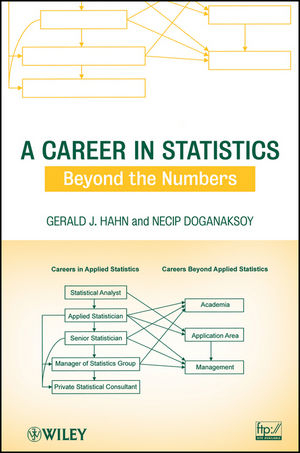
A Career in Statistics
John Wiley & Sons Inc (Verlag)
978-0-470-40441-6 (ISBN)
A valuable guide to a successful career as a statistician A Career in Statistics: Beyond the Numbers prepares readers for careers in statistics by emphasizing essential concepts and practices beyond the technical tools provided in standard courses and texts. This insider's guide from internationally recognized applied statisticians helps readers decide whether a career in statistics is right for them, provides hands-on guidance on how to prepare for such a career, and shows how to succeed on the job.
The book provides non-technical guidance for a successful career. The authors' extensive industrial experience is supplemented by insights from contributing authors from government and academia, Carol Joyce Blumberg, Leonard M. Gaines, Lynne B. Hare, William Q. Meeker, and Josef Schmee. Following an introductory chapter that provides an overview of the field, the authors discuss the various dimensions of a career in applied statistics in three succinct parts:
The Work of a Statistician describes the day-to-day activities of applied statisticians in business and industry, official government, and various other application areas, highlighting the work environment and major on-the-job challenges
Preparing for a Successful Career in Statistics describes the personal traits that characterize successful statisticians, the education that they need to acquire, and approaches for securing the right job
Building a Successful Career as a Statistician offers practical guidance for addressing key challenges that statisticians face on the job, such as project initiation and execution, effective communication, publicizing successes, ethical considerations, and gathering good data; alternative career paths are also described
The book concludes with an in-depth examination of careers for statisticians in academia as well as tips to help them stay on top of their field throughout their careers. Each chapter includes thought-provoking discussion questions and a Major Takeaways section that outlines key concepts. Real-world examples illustrate key points, and an FTP site provides additional information on selected topics.
A Career in Statistics is an invaluable guide for individuals who are considering or have decided on a career in statistics as well as for statisticians already on the job who want to accelerate their path to success. It also serves as a suitable book for courses on statistical consulting, statistical practice, and statistics in the workplace at the undergraduate and graduate levels.
Gerald J. Hahn, PhD, worked at the GE Global Research Center for 46 years, where he managed its statistics group for 28 years and was elected a Coolidge Fellow, the organization's highest honor, in 1984. A Fellow of the American Statistical Association (ASA) and American Society for Quality (ASQ), Dr. Hahn is the author of numerous papers and the coauthor of Statistical Models in Engineering; Statistical Intervals: A Guide for Practitioners; and The Role of Statistics in Business and Industry, all published by Wiley. He has received many professional awards and served as adjunct professor at various universities. Necip Doganaksoy, PhD, is a Statistician and Principal Technologist at the GE Global Research Center, where he has worked for over 20 years; he is also an Adjunct Professor at Union Graduate College. A Six Sigma Master Black Belt and a Fellow of ASA and ASQ, Dr. Doganaksoy has written more than 60 articles on quality, reliability, and productivity improvement and coauthored The Role of Statistics in Business and Industry (Wiley). He received ASQ's William G. Hunter Award in 2009.
PREFACE XIII
ACKNOWLEDGMENTS XVII
CHAPTER 1 PROLOGUE: A CAREER IN STATISTICS 1
1.1 About This Chapter 1
1.2 What is Statistics? 1
1.3 Who is a Statistician? 2
1.4 Who Employs Statisticians? 3
1.5 The Statistical Thought Process and What Makes it Special 4
1.6 Many Skills Required 7
1.7 Beyond the Workplace 8
1.8 Some Downsides of a Career in Statistics 9
1.9 The Excitement of a Career in Statistics 10
1.10 Embarking on a Career in Statistics 11
1.11 Accreditation 15
1.12 Professional Societies 16
1.13 A Preview 16
1.14 Further Reading 17
1.15 Major Takeaways 18
Discussion Questions 19
PART I THE WORK OF A STATISTICIAN 21
CHAPTER 2 WHAT STATISTICIANS DO IN BUSINESS AND INDUSTRY 23
2.1 About This Chapter 23
2.2 Manufactured Product Applications 23
2.3 Service Business Applications 28
2.4 Process Improvement 30
2.5 Further Applications 31
2.6 Major Takeaways 32
Discussion Questions 32
CHAPTER 3 WHAT STATISTICIANS ENGAGED IN OFFICIAL GOVERNMENT STATISTICS DO 35
3.1 About This Chapter 35
3.2 The Scope of Official Statistics 36
3.3 Examples of the Work 39
3.4 Challenges of the Work 41
3.5 Research Opportunities 45
3.6 Some Major Employers in the U.S. Federal Government 46
3.7 Required Credentials 47
3.8 Integration of U.S. Government Statistical Activities 49
3.9 Local Official Government Statistics Activities 50
3.10 Government Statisticians Outside The United States 51
3.11 Compensation and Other Considerations 52
3.12 Sources of Further Information 53
3.13 Major Takeaways 53
Discussion Questions 54
CHAPTER 4 WHAT STATISTICIANS DO: SOME OTHER APPLICATION AREAS 57
4.1 About This Chapter 57
4.2 Regulatory Activities 57
4.3 Health 59
4.4 National Defense 61
4.5 Other Scientific Research 62
4.6 Social and Behavioral Sciences 65
4.7 Teaching (in Nonacademic Settings) 71
4.8 Some Further Institutes for Research in the United States 71
4.9 Major Takeaways 73
Discussion Questions 73
CHAPTER 5 THE WORK ENVIRONMENT AND ON-THE-JOB CHALLENGES 75
5.1 About This Chapter 75
5.2 Receptiveness to Statistics and Statisticians 75
5.3 Where do Statisticians Fit into the Organization? 79
5.4 Two Modes of Operation 80
5.5 Grading Systems 82
5.6 Globalization 83
5.7 Hail to Our Managers! 84
5.8 Some Challenges 86
5.9 Women in Statistics 90
5.10 Major Takeaways 93
Discussion Questions 94
PART II PREPARING FOR A SUCCESSFUL CAREER IN STATISTICS 97
CHAPTER 6 CHARACTERISTICS OF SUCCESSFUL STATISTICIANS 99
6.1 About This Chapter 99
6.2 Analytical and Technical Skills 100
6.3 Communication and Interpersonal Skills 100
6.4 Ability to Size Up Problems and See the “Big Picture” 101
6.5 Flexibility 102
6.6 A Proactive Mindset 102
6.7 Persistence 103
6.8 A Realistic Attitude 104
6.9 Enthusiasm and Appropriate Self-Confidence 105
6.10 Ability to Prioritize, Manage Time, and Cope with Stress 105
6.11 Team Skills 106
6.12 Leadership Skills 106
6.13 Ability to Properly Apply and Adapt Knowledge 107
6.14 Passion for Lifelong Learning 108
6.15 Further Reading 108
6.16 As Others See It 108
6.17 Major Takeaways 111
Discussion Questions 111
CHAPTER 7 EDUCATION FOR SUCCESS 113
7.1 About This Chapter 113
7.2 The Statistics Advanced Placement Course and Other High School Programs 114
7.3 Degrees in Statistics: The Numbers 114
7.4 How Far To Go: Bachelor’s, Master’s, or Ph.D. Degree? 116
7.5 Selecting the Right School and Program 120
7.6 Statistical Education: Setting the Foundations 125
7.7 Coursework in Statistics 126
7.8 Statistical Computing and Software 131
7.9 Some Other Recommendations 134
7.10 Internships and University Consulting 138
7.11 Entering Statistics from Other Fields 141
7.12 Further Resources 142
7.13 Concluding Comment: The Limits of Formal Statistical Education 142
7.14 As Others See It 143
7.15 Major Takeaways 145
Discussion Questions 146
CHAPTER 8 GETTING THE RIGHT JOB 149
8.1 About This Chapter 149
8.2 Defining Career Goals 149
8.3 Identifying Opportunities 151
8.4 Resume Writing 154
8.5 The Job Interview 157
8.6 Follow-Up 164
8.7 Providing References 165
8.8 Some Further Hints 165
8.9 Assessing Job Offers 166
8.10 Major Takeaways 170
Discussion Questions 171
PART III BUILDING A SUCCESSFUL CAREER AS A STATISTICIAN 173
CHAPTER 9 ON-THE-JOB STRATEGIES: PROJECT INITIATION AND EXECUTION 175
9.1 About This Chapter 175
9.2 Project Initiation 175
9.3 Project Execution 184
9.4 As Others See It 190
9.5 Major Takeaways 194
Discussion Questions 194
CHAPTER 10 ON-THE-JOB STRATEGIES: COMMUNICATION, PUBLICIZING, AND ETHICS 197
10.1 About This Chapter 197
10.2 Communication, Communication, Communication 197
10.3 Publicizing Statistics (And Statisticians) 205
10.4 Ethical Considerations 207
10.5 Major Takeaways 216
Discussion Questions 216
CHAPTER 11 GETTING GOOD DATA: A KEY CHALLENGE 219
11.1 About This Chapter 219
11.2 Designed Experiments 220
11.3 Census and Random Sampling Studies of Human and Other Populations 221
11.4 Systems Development Studies 224
11.5 Observational Studies 225
11.6 Hints for Getting the Right Data 233
11.7 A Process for Data Gathering 240
11.8 Major Takeaways 247
Discussion Questions 248
CHAPTER 12 CAREER PATHS 251
12.1 About This Chapter 251
12.2 Some Roles for Applied Statisticians 251
12.3 Other Major Roles to which Applied Statisticians Might Aspire 253
12.4 Some Career Paths 256
12.5 More on Statistical Leadership 258
12.6 Contributions Beyond the Workplace 259
12.7 Some More Career Examples 261
12.8 Putting It All Together 264
12.9 Major Takeaways 265
Discussion Questions 265
PART IV FURTHER PERSPECTIVES: CAREERS IN ACADEMIA AND PROFESSIONAL DEVELOPMENT 267
CHAPTER 13 CAREERS IN ACADEMIA 269
13.1 About This Chapter 269
13.2 What Statisticians in Academia do: An Overview 270
13.3 Types of Positions 273
13.4 Location within the Institution 277
13.5 More on Tenure 277
13.6 Life Beyond Tenure 279
13.7 Teaching Challenges 280
13.8 Research Challenges 286
13.9 Consulting Challenges 292
13.10 Administrative Service Challenges 294
13.11 Professional Service Challenges 295
13.12 More on the Academic Environment 296
13.13 Training to Become an Academic Statistician 298
13.14 Career Paths 300
13.15 Downsides of a Career as an Academic Statistician 303
13.16 Bright Sides of a Career as an Academic Statistician 304
13.17 A Career as a Statistician in Academia: A Summary Comparison 305
13.18 Major Takeaways 305
Discussion Questions 307
CHAPTER 14 MAINTAINING THE MOMENTUM 309
14.1 About This Chapter 309
14.2 Some Internet Resources 310
14.3 Formal Education 311
14.4 Technical and Professional Journals 312
14.5 Technical Conferences 315
14.6 Future Opportunity Areas 318
14.7 Major Takeaways 319
Discussion Questions 319
REFERENCES 321
INDEX 331
| Zusatzinfo | Photos: 5 B&W, 0 Color; Tables: 50 B&W, 0 Color; Graphs: 50 B&W, 0 Color |
|---|---|
| Verlagsort | New York |
| Sprache | englisch |
| Maße | 155 x 234 mm |
| Gewicht | 522 g |
| Themenwelt | Geisteswissenschaften ► Geschichte ► Regional- / Ländergeschichte |
| Geschichte ► Teilgebiete der Geschichte ► Wirtschaftsgeschichte | |
| Mathematik / Informatik ► Mathematik ► Wahrscheinlichkeit / Kombinatorik | |
| Wirtschaft ► Volkswirtschaftslehre ► Makroökonomie | |
| ISBN-10 | 0-470-40441-8 / 0470404418 |
| ISBN-13 | 978-0-470-40441-6 / 9780470404416 |
| Zustand | Neuware |
| Haben Sie eine Frage zum Produkt? |
aus dem Bereich


